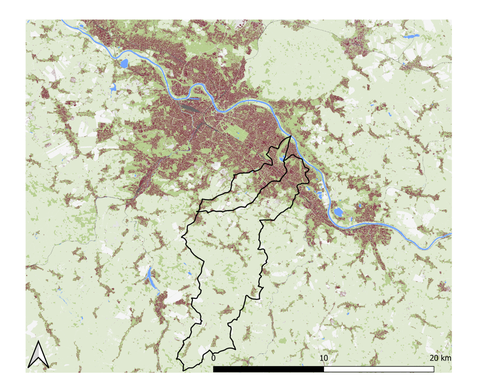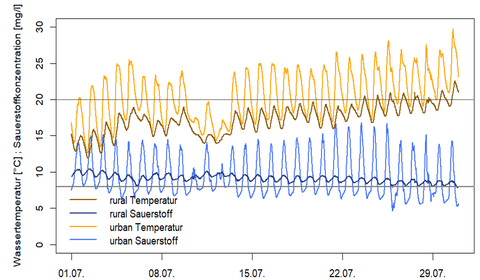Urban Observatory
Timelapse at a monitoring site of the observatory located at Lockwitzbach © Jakob Benisch & Stephan Becker
The aim of research in urban water management is to identify the relevant compound fluxes and the interaction between drainage network and ecosystem. This is the solid basis from where sustainable management approaches for the concerning environmental compartments can be developed. To gain that necessary information on at a high temporal resolution, the working group on Urban Hydrology of the Institute for Urban Water Management established an integrated monitoring network in the city area of Dresden. Compound fluxes in the sewers as well as the receiving waters are monitored with state of the art technologies to give detailed insights in complex runoff and discharge processes as well as on (stress) conditions in the adjacent streams.

Our research-catchments: Geberbach (left) & Lockwitzbach (right)

Portable Dischargemonitoring at CSOs in the Lockwitzbachcatchment
The Urban Observatory consists of eight measurement stations in the catchment of Lockwitzbach and Geberbach, both are small streams flowing through the city of Dresden. In the Lockwitzbach catchment there are two stations directly located in the creek and three more in the sewer network (one in a storm water outlet & two in combined sewers) discharging in the creek during (heavy) rain events. The concentration of oxygen, potassium, chloride, nitrate as well as bulk organic pollutants (COD, TOC, DOC, equivalent concentrations from spectrometer probes) pH, conductivity and discharge are being recorded every minute. Data is availble for emplyees and students of TU Dresden from our dashboards. To get corrected data get in touch with Jakob Benisch. Sediment traps as well as additional auto samplers are installed at the stations and can be triggered during events. Furthermore, water temperature and portable discharge meters are mounted in the stream and combined sewer overflows and storm water outlets. A map of all important points in the catchments can be found here.

Temperature and oxygenconcentration in the urban (orange) and rural (blue) subcatchment
Recent research focuses on detecting the effects of the Urban Stream Syndrome on the investigated stream. Especially heavy rains are of main interested, as the high temporal and special variability of those events and their contribution to the urban discharge can be well tackled back with the network.
Since 2019 we are cooperating with the environmental department of Dresden to monitor the effects of the renaturation of Geberbach (only in German). There are three stations, recording water level and physicochemical parameters, that are supposed to show the effect of the planned renaturation measures.
